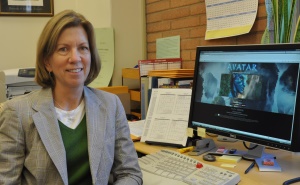Scientist Jodie Holt brings her knowledge of invasive plants and weeds to the blockbuster Avatar
Scientist Jodie Holt typically spends her days researching thistles and other invasive weeds that can play havoc on planet Earth. But when the producers of the blockbuster Avatar called, she suddenly found herself immersed in the lush plant life of Pandora, the remote moon where much of the film’s action is based.
“The filmmakers were looking for someone to help actress Sigourney Weaver prepare for her role as a field botanist in the film,” says Holt, a Fellow of the Weed Science Society of America and Chair of the Department of Botany and Plant Sciences at the University of California at Riverside. “I agreed to show her how someone in the profession would dress and behave and how to approach a plant to take samples.”

WSSA Fellow Jodie Holt Photo courtesy of UCR Office of Strategic Communications
But Holt’s involvement soon broadened. She found herself using what she knows about plants and weeds to help filmmakers round out the new world they were creating.
When the book “Avatar: An Activist Survival Guide” was being created as a companion to both the movie and an Avatar videogame, Holt wrote a chapter on the flora of Pandora. It features vivid descriptions she created for an array of imaginary plants – from botanical characteristics to ecological details. She even established a simple taxonomy with both common and Latin names.
“It was one of the most fun aspects of the project,” she says.
Information from producer James Cameron on the moon’s environment became a starting point for deciding how plants in his imaginary world would have adapted. In the absence of a strong gravitational pull, for example, Holt explained that some plants would grow to gigantic heights and that roots wouldn’t always point down.
“Originally he wanted the plants to have a nervous system,” she said. “But I thought that was too far-fetched and suggested signal transduction instead. It’s a type of cell to cell communication that is being actively studied today, and it seemed credible to me that 150 years into the future, at the time the film is set, we would know a lot more about it.”
Many of the “nastier” plant characteristics Holt envisioned are directly informed by her background in weed science and botany, including exploding seed pods, caustic oils and resins, the ability to trap and digest small animals – and more.
One example: Pandora’s scorpion thistle (Scorpioflora maxima), also known as “poisonwater plant,” exudes an acidic sap that can even eat through rock. It clears the soil at the base of the stalk and creates a nutrient-rich bed for seed germination. Holt’s inspiration was the artichoke thistle (Cynara cardunculus), her specialty back on Earth. It can produce hundreds of seeds from a single flower head that drop and germinate near the base of the parent plant.
“Fortunately it’s only on Pandora that weeds shoot poison-tipped darts,” she jokes. “If our weeds truly had some of these traits, we’d be in real trouble.”
Holt’s weed science background is perhaps best reflected in a short essay for the field guide on the dangers of introducing Pandora’s plants on planet Earth. It echoes the current-day concerns weed scientists have when plants are transported from their natural environment to someplace new. She writes that even seemingly benign species have the capacity to become weedy invaders that can “profoundly impact native biodiversity and permanently alter natural ecosystems.”
Though Holt’s father now calls her the “botanist to the stars” and both her son and nephew finally think she’s cool, she says one of the greatest rewards of the project is promoting an interest in weed science and botany.
“I’m a teacher at heart, and it’s exciting to see how the movies can teach while they entertain,” she says.
__________
About the Weed Science Society of America:
The Weed Science Society of America, a nonprofit professional society, was founded in 1956 to encourage and promote the development of knowledge concerning weeds and their impact on the environment. The Weed Science Society of America promotes research, education and extension outreach activities related to weeds, provides science-based information to the public and policy makers, and fosters awareness of weeds and their impacts on managed and natural ecosystems. For more information, visit http://www.wssa.net.
